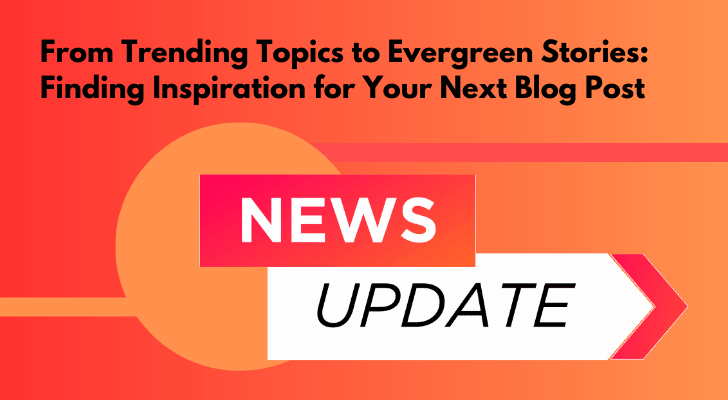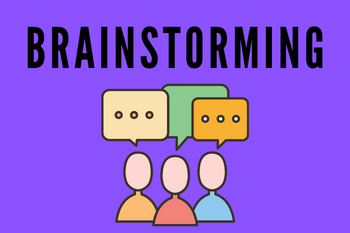Are you struggling to come up with fresh and exciting ideas for your next blog post? Do you find yourself constantly chasing after trending topics, only to realize that they quickly become outdated and irrelevant? I feel the same. It's exciting to follow new trends and quickly write about them daily. This helps me stay current and keeps my writing fresh.
But I'm a freelance writer, and one of the challenges I face is coming up with new and interesting topics to write about. I admit that there are times when I get lost trying to find something new to write about. When this happens, I often have to take a step back and remind myself of some of the methods I use to generate new ideas.
There's always something new and shiny on the internet, but that doesn't mean you should focus all of your attention on it. Trends come and go, but certain stories are evergreen and will always be relevant. If you want to create content that people will continue to read and enjoy for years to come, you need to focus on creating timeless evergreen stories. Let’s find out how you can shift your focus from fleeting trends to timeless evergreen stories.

Should I Create a News/Trending Site or an Evergreen Site?
Trending topics can attract a larger audience, especially if you want to generate a lot of traffic in a short amount of time. You’re not going to open a new site and drive traffic right away. Everything takes time, but if you keep creating content about current affairs, you can attract attention and get people to click. Writing about a current event or a popular trend can help you tap into an existing conversation and gain attention for your content.
But trending topics often have a short shelf life, so your content may become irrelevant in a matter of weeks or even days. If you're looking to have many of your pages remain relevant and attract readers over a longer period, you may want to focus on evergreen stories.
Evergreen content can be more difficult to rank for because there's already a lot of it out there, and it can be hard to compete with established pieces.
Having said that, evergreen stories can continue to generate traffic and engagement for your site, even long after you've published them. They can also help establish your site as a valuable resource for readers, which can lead to increased brand awareness and loyalty.
Brainstorming Blog Post Topics
Brainstorming is a process of generating creative and innovative ideas through free association and idea generation. Here are the steps you can follow.
- Create a comfortable and conducive environment: Choose a comfortable and relaxed setting for your brainstorming session. Make sure you have access to necessary tools such as pens, paper, or a whiteboard.
- Encourage free thinking and idea generation: Allow yourself to think freely without judgment or criticism. The goal is to generate as many ideas as possible, even if they seem impractical or unrealistic.
- Use different brainstorming techniques: Use different techniques such as mind mapping, SWOT analysis, or random word association to generate new ideas and connections between ideas.
- Take breaks and revisit the ideas: Take breaks during the brainstorming session to recharge and revisit the ideas later with fresh eyes.
- Evaluate and refine ideas: Once you've generated a list of ideas, evaluate and refine them based on their feasibility, relevance, and potential impact.
- Use inspiration sources: Read books, articles, or blogs related to your topic to get inspiration and new ideas. Look for different perspectives and angles to approach the topic.
I suggest that you take a look at what's trending in your industry. Check social media, Google News, and other news sources to see what people are talking about. You can use these trends as inspiration for your own blog post topics.

How about coming up with evergreen topics that would be relevant to your visitomers? These are topics that will always be relevant and useful, no matter when they're read. For example, if you're a financial planner, an evergreen topic might be "How to Save for retirement."
And don't forget about personal stories. Sometimes the best blog posts are those that come from personal experience. Write about something that happened to you recently or something that you're passionate about. Your visitomers will appreciate the authenticity and connection.
Checking Google Trends
If you're looking for inspiration for your next blog post, checking Google Trends is a great place to start. You can use the "Trending Now" section to see what topics are currently trending on Google, or you can use the "Explore Topics" section to find ideas for evergreen stories.
When you use Google Trends, you can see how popular a particular topic is by looking at the search volume over time. You can also see which regions are interested in that topic, and you can filter the results by time period, category, and type of story.
Looking at trending topics can give you a good idea of what people are interested in right now. However, remember that these topics may not be relevant in a few weeks or months. If you want to write an evergreen story, choose a topic that will be relevant for a long time.
For example, if you're writing about parenting, you could write about potty training tips or ways to get your child to sleep through the night. These topics will always be relevant to parents, even as their children grow older.
Analyzing Your Competitors' Content
If you're stuck on what to write for your next blog post, one of the best things you can do is take a look at what your competitors are writing about. Not only will this give you some ideas for topics, but it will also help you see what's working well for them and what isn't.
To start, take a look at the top 10 blogs in your industry and make a list of the topics they're covering. Then, take a look at the social media sharing metrics for each post (shares, likes, comments, etc.). This will give you an idea of which topics are resonating with their audience and which aren't.
Once you have a list of potential topics, it's time to start digging into the actual content. Read through a few of the posts on each topic and take note of anything that stands out to you - both good and bad. Are there any particular formats or styles that seem to work well? Are there any areas where their coverage is lacking?
Armed with this information, you should be able to come up with a few ideas for your own blog post that will give you a leg up on the competition.
Looking for Evergreen Stories
Trends fizzle out, sooner or later. It means that if your blog is solely following the trends when you stop, you're left with an outdated blog post that doesn't provide any value to your readers.
That's why there’s a good reason to focus on evergreen stories - stories that will remain relevant long after the initial publish date. When you have a few evergreen stories in your back pocket, you'll always have something to write about - even when the latest trends have come and gone.
So where do you find inspiration for evergreen stories? Here are a few ideas:
Something Interesting To Yourself
Write about timeless topics that interest you. These could be things like tips for living a better life, advice for starting a business, or ways to improve your productivity.
Share Your Stories

Share stories from your own life that will resonate with others. Readers love personal anecdotes that they can relate to.
- Make it relatable: People are more likely to engage with stories that they can relate to. Share stories that are relevant to your audience and that they can connect with on a personal level.
- Keep it concise: Avoid rambling or going off-topic. Keep your stories concise and to the point, so that your audience stays engaged.
- Use descriptive language: Use descriptive language to bring your stories to life. Paint a vivid picture of the characters, setting, and action in your story, so that your audience can imagine themselves in the scene.
- Build suspense: Create suspense and anticipation in your stories by building up to a climax or reveal. This can keep your audience engaged and eager to hear what happens next.
- Use humor: Humor can be a great way to make your stories more engaging and entertaining. Use humor to lighten the mood and add some levity to your stories.
- Add value: Make sure your stories add value to your visitomers. Share insights, lessons, or takeaways that your audience can apply to their own lives or work.
Offer helpful resources that people can come back to again and again. This could be a list of the best books on a certain topic or a directory of websites for entrepreneurs.
Share Your Knowledge
Share your expert knowledge on a particular subject matter. If you're an expert in something, chances are there are others out there who want to learn from you.
- Choose the right format: Choose the right format for your content. This could be a blog post, podcast, video, or webinar, depending on your audience and the topic you are covering.
- Use clear, concise language: Use clear, concise language to explain complex concepts and ideas. Avoid jargon and technical terms that your audience may not understand.
- Provide examples: Use real-world examples to illustrate your points and help your audience understand how your expertise applies to their lives or work.
- Be generous with your knowledge: Share your expertise generously and openly. Provide actionable insights and tips that your audience can apply to their own lives or work.
- Engage with your audience: Engage with your audience and encourage them to ask questions or share their own insights and experiences. This can help build a sense of community around your expertise.
Gather Latest News and Gossip for Your Website

To gather the latest news and gossip for your blog, you can follow these steps:
- Identify reliable sources: Identify reliable sources of news and gossip relevant to your niche. These sources can include mainstream news outlets, celebrity blogs, social media, and industry publications.
- Set up alerts: Set up alerts on search engines and social media platforms for relevant keywords and topics. This can help you stay informed of the latest news and trends in your niche.
- Follow influencers: Follow influencers and experts in your niche on social media and subscribe to their newsletters or blogs. This can help you stay up-to-date on the latest news and trends.
- Monitor social media: Monitor social media platforms such as Twitter and Instagram for breaking news and trending topics related to your niche. You can also engage with your audience and ask them to share news and gossip they come across.
- Attend events: Attend industry events and conferences related to your niche to network and stay informed of the latest developments and trends.
- Fact-check and verify the information: Verify the information you gather from different sources to ensure it is accurate and reliable. Avoid sharing unverified or false information on your website.
Remember that it is important to maintain journalistic ethics and integrity while gathering news and gossip for your website. Always strive to provide accurate, relevant, and high-quality content to your audience.
How Can I Reach Out To Influencers And What Can I Say To Them?
Reaching out to influencers can be a great way to increase your website's visibility and attract more traffic. Here are some steps you can follow to reach out to influencers:
- Identify relevant influencers: Identify influencers who are relevant to your niche and target audience. Look for influencers who have a significant following on social media and a high engagement rate.
- Build a relationship: Before reaching out to an influencer, build a relationship with them by engaging with their content and sharing their posts. This can help you establish a connection and show that you are genuinely interested in their work.
- Reach out with a personalized message: When reaching out to an influencer, send a personalized message that highlights why you think they would be interested in your website or content. Be specific and mention what you like about their work and how it relates to your website.
- Offer value: Offer something of value to the influencer, such as a guest post or a collaboration opportunity. This can help you build a mutually beneficial relationship and increase your website's visibility.
- Be respectful and professional: Be respectful and professional in your communication with the influencer. Avoid being pushy or overly promotional, and always thank them for their time and consideration.
Here is an example of what you could say in your outreach message to an influencer:
Hi [Influencer's Name],
I hope this message finds you well. I've been a fan of your work for a long time and really appreciate the valuable content you create for your audience.
I recently launched a website in [your niche], and I think your audience would be interested in some of the content I've been producing. I would be honored if you would consider sharing some of my posts on your social media channels or including a link to my website in your upcoming content.
In return, I would be happy to write a guest post for your blog or collaborate on a project together. I think we could create something really valuable for our audiences.
Thank you in anticipation for your time and consideration. I look forward to hearing from you.
Best regards,
[Your Name]
Ask Your Visitors What They Want to Read
Ask your visitors what they want from you directly - not only will this help ensure that you're writing about topics that your audience is interested in, but it can also help you come up with new ideas that you may not have thought of on your own. Here are some ways you can take;
- Conduct a survey: Conduct a survey on your website or through email to ask your visitors about their interests and preferences. You can ask questions such as “What kind of blog posts or books do you normally read?” "Are there any topics that you’re interested in reading about?" etc.
- Use social media polls: Use social media platforms such as Twitter or Instagram to conduct polls and ask your followers what type of content they want to see.
- Ask for feedback: Ask your visitors for feedback in your blog posts or through a feedback form on your website. Encourage them to share their thoughts and suggestions for future content.
- Analyze website analytics: Use website analytics tools such as Google Analytics to analyze which pages and topics on your website are getting the most traffic and engagement. This can give you insights into what your audience is interested in reading.
Remember to use the feedback you receive from your visitors to guide your content strategy and create content that is valuable and relevant to your audience. So next time you're feeling stuck for inspiration, don't be afraid to reach out to your audience and ask them what they'd like to see from you.
Conclusion
As a blogger, you may want to stay on top of the latest trends and current events to keep your content relevant. But evergreen stories can be just as effective for engaging readers when you’re looking for something timeless.
Put your own spin, that’s I would say, on trending topics or delving into evergreen content. You sure can find fresh ideas for your next blog post that will capture the attention of readers both now and in the future.

